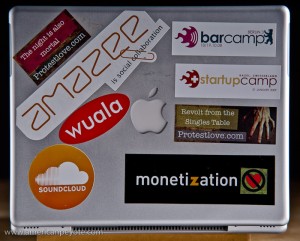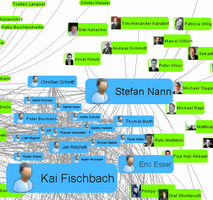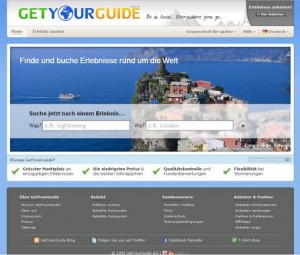 One of the coolest things about the Web Monday Zurich meetings are the cool locations. Every Monday it takes place in a different place, and after a while you get the feeling of exploring the unique office spaces of the Zurich tech scene. One month you’re sitting in the cozy office space of Amazee, the next you’re chilling on the comfortable couch of Wuala, I took a ride down the rabbit hole slide at Google and on May 3rd, 2010, I got to check out Big Blue, the IBM European headquarters in Bahnhof Altstetten in Zurich. IBM is famous for being (historically) the Evil juggernaut of Silicon Valley (my feeling via Steve Jobs), the beast which Apple and Microsoft rallied against in the early days of the personal computer wars. But now that Apple is the old skool corporate entity – well…IBM sort of feels like the nimble innovation-minded corporation reborn from the ashes of the Silicon computer wars. The people there seem energetic and free-minded – like tech-prophets marching into the future with their heads high and without the corporate giant stigma you see when watching the Pirates of Silicon Valley.
One of the coolest things about the Web Monday Zurich meetings are the cool locations. Every Monday it takes place in a different place, and after a while you get the feeling of exploring the unique office spaces of the Zurich tech scene. One month you’re sitting in the cozy office space of Amazee, the next you’re chilling on the comfortable couch of Wuala, I took a ride down the rabbit hole slide at Google and on May 3rd, 2010, I got to check out Big Blue, the IBM European headquarters in Bahnhof Altstetten in Zurich. IBM is famous for being (historically) the Evil juggernaut of Silicon Valley (my feeling via Steve Jobs), the beast which Apple and Microsoft rallied against in the early days of the personal computer wars. But now that Apple is the old skool corporate entity – well…IBM sort of feels like the nimble innovation-minded corporation reborn from the ashes of the Silicon computer wars. The people there seem energetic and free-minded – like tech-prophets marching into the future with their heads high and without the corporate giant stigma you see when watching the Pirates of Silicon Valley.
The IBM building has a fantastic atrium, where you can mingle and enjoy an apero before heading into the auditorium. There’s a giant sort of aquarium with blue lights and a couple of huge serves on display, it’s an interesting place to have a beer, and IBM beer surpasses the offerings at Google. I enjoyed a weissbeer while getting my head slightly twisted for my presentation on Web Portraits Zurich and mingled with folks. But before I got up on stage and tried to make a fool of myself, we were treated to talks and thoughts from IBM, Dein Deal, and Kooaba.
IBM
Siddhartha Arora (from IBM) was our host for evening, and presented the IBM Global Entrepreneur Program. Basically, IBM is interested in working with startup teams to build a smarter planet. This is an awesome higher purpose to hear from giant company like IBM. So what do startups need when starting out? They need to be low cost, they need mentoring and networking, and then they need marketing and sales. And if you’re accepted into the program, IBM offers it’s project support, people, and marketing strength. Teams would have access to IBM servers and technology support to allow the growth of new ideas and startups. What’s in it for Big Blue? The intellectual property stays with the startup, but I think there’s the belief that helping technology grow is a good thing. If you have a sweet idea that works well on a small startup scale, at some point you’ll need to scale toward the sky, and you need IBM for that. So, basically IBM is enabling new ideas for a smarter planet by supporting startups, and hopes to benefit from the eventual resources required for cool startup ideas to turn into killer companies. I think that this approach is what big companies like Big Blue should be doing to foster and encourage the spread and evolution of ideas, and the higher purpose here, “To build a smarter planet” sounds authentic and is highly inspirational. If you’re interested, you can apply for the program at www.ibm.com/isv/startup.
Dein Deal
There are a number of cool social marketing ways to form new selling opportunities, and Dein Deal is basically taking the idea of grouponworkes.com and putting it in practice in Switzerland. The concept is as old as supply and demand, if you pool the buying power of people, you can reduce the price of a product. Dein Deal focuses on providing deals on “experiences” in Switzerland. What’s an experience? Going out to dinner, a massage, wellness, whatever can be offered. It’s good for deal providers because they get a lot of people using their services, and encourages people to come back after trying it out. It’s good for Dein Deal, because the concept has already been proven successful in a ton of other countries. It’s a copycat concept, but who cares? If something works in one place (like America or Germany) why not see if will downscale to a small country like Switzerland?
Kooaba
I’ll be honest, I love the idea of Kooaba, because as a photographer and visual imagery junky, it’s the technology I was always excited about. And since I live in a cave, I also didn’t know the technology already existed and felt like an idiot in a crowd of brainiacs. What does Kooaba do? Image recognition. That’s it. That’s what I love to learn about. The Kooaba technology recognizes objects in images. If you can identify these elements and then link it to something (like Amazon) you have a very powerful tool for image searching and monitization of online imagery. Why is this important? Because you can’t search for images on the internet. You can only search for tags and text associated to imagery, but you can’t draw a house and find images of houses on Google (not that I know of at least). The idea is that you have an iPhone, Android, smart phone, take a picture of something, and then you get buying info on that object (online stores, Amazon, etc.). Google has a similar application called Google Goggles, which is now the main competitor of Kooaba. The old competitor used to be a startup called Snaptell, who was bought by Goolge (see how the circle of life works).
Kooaba isn’t able to recognize everything though. If you have a picture of a cat, it won’t know what to do with it. Basically the technology works by querying a database, recognizing an object in the image, and then sending the user to buying services. They also have some applications like Paperboy, which is used to take a picture of a magazine article, and then you get connected to the electronic version online on your smart phone. They also have Shooting Star, a photo management app with flickr integration, and using the image recognition technology your image is instantly tagged based on recognized objects. Very cool I think. At the moment it looks good for tagging according to landmarks and scenery, which is great for travel photography. However, this is really just a very small part of what image recognition has the potential to do for retail business and advertising.
Why is imagery recognition so important? Because we love celebrities because of who they are in our minds and love to buy the shit they pose with in magazines. So companies pay advertising agencies to develop ad campaigns with famous faces to sell stuff like Nespresso and clothes. But with image recognition all you would need to do is have a picture on an Android/iPad/iPhone/internet tablet, and in an online magazine and click on an object that Lady Gaga is wearing in some random article about music and then using location based information technology your device could be connected with the closest store offering ghastly latex shoes or you instantly get One-Click link to an Amazon store. Of course, this sucks for the advertising photography industry because it means that any image can be used as an ad, not just those that have been licensed to ad agencies. Imagine my Urban Ninja photos on Flickr being used to sell Katana Samurai swords in Austin, Texas when some kid is looking for cool martial arts photos on his lunch break at school? My images would have aided in selling a product, but I get no split from the sale. But that’s the future, and it’s already here.
Web Portraits Zurich
The last presentation of the night was me and I went low-tech as I presented the Web Portraits Zurich project that I started on Amazee. I went over the concept, explaining why I started taking photos, and how I got bored with self-portraits and started taking to women on the internet to setup model shoots, and then came to the web portrait project idea. I stared the portrait project because I’m continually inspired by the thoughts and visual style of the people I meet in the startup scene. Then it was the most natural thing in the world to start a portrait project, the higher purpose being, “to create cool imagery of people in the startup scene around Zurich and Switzerland.”
I presented images from Mathias Möller and Lukas Fischer, and then talked a bit about the brain storming process and online tools we’ve been using to develop portrait ideas like Google Wave and Cacoo. The next portrait will be with Dania and Gregory from Amazee, and if all goes well a giant Tech-Flesh jungle portrait of the Amazee team will find it’s way onto the net.
Zurich is an exciting place to be if you’re into the startup scene. For more info on what’s happening check out the Web Monday Zurich group on Amazee.com or UX Chuchi or Marketing Chuchi, or just walk the tech streets and explore the possibilities.





 The
The  Next up Andreas Hoffmann gave a presentation on a challenge/contest from UBS. Basically, UBS wants to know how to use Web 2.0 in the banking business. All they want is 4-5 PowerPoint slides by Dec. 24th explaining your concept (details at the
Next up Andreas Hoffmann gave a presentation on a challenge/contest from UBS. Basically, UBS wants to know how to use Web 2.0 in the banking business. All they want is 4-5 PowerPoint slides by Dec. 24th explaining your concept (details at the  Last up Mathias Vogel talked about the
Last up Mathias Vogel talked about the  As part of the FHNW program two projects were also presented. Amazee is included in one of their partner projects, one goal being the creation of a sort of Karma Index into the Amazee system, which will include a recommendation engine so that new users are quickly connected with other users with similar interests when they join. I find this to be fantastic, because the first thing you wonder about when joining an online organization like Amazee (or Stylished, or Talenthouse, or Flickr) is how to find the people you want to work with. My mind had become a tad befuddled by this point from the free beer, but it was able to coherently listen to the presentation of the
As part of the FHNW program two projects were also presented. Amazee is included in one of their partner projects, one goal being the creation of a sort of Karma Index into the Amazee system, which will include a recommendation engine so that new users are quickly connected with other users with similar interests when they join. I find this to be fantastic, because the first thing you wonder about when joining an online organization like Amazee (or Stylished, or Talenthouse, or Flickr) is how to find the people you want to work with. My mind had become a tad befuddled by this point from the free beer, but it was able to coherently listen to the presentation of the 

